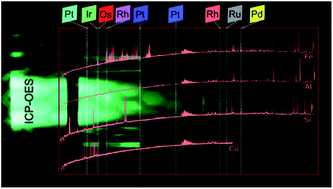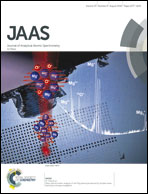Matrix complexity effect on platinum group metals analysis using inductively coupled plasma optical emission spectrometry†
Abstract
Recent global actions to mitigate climate change have sparked the development of critical green technologies that rely on strategic materials with unique properties. Examples include Platinum Group Metals (PGMs) that are in increasingly high demand in the manufacturing of green catalysts, but facing supply uncertainty. For tackling the sustainability challenges associated with PGMs supply, activities have been initiated to mine these elements from low-grade ores and postconsumer automotive catalytic converters. However, such sources are highly concentrated with other elements, such as iron, aluminum, and silicon, causing analytical interferences during PGM quantitative analyses, making the measurements unreliable. Here, we performed a systematic investigation to determine the effect of matrix complexity in terms of analyte concentration, number of interferents, concentration of interferents, and identity of interferents on the measurement performance of nine emission lines of PGMs, when inductively coupled plasma optical emission spectrometry (ICP-OES) is utilized. Results indicate that depending on the combination of parameters, the concentration of all PGMs, except for osmium, is underestimated when the matrix contains Fe, Ca, Mn, Cr, Mg, Al, Si, Pb, and Cu. This observation is attributed to spectral interferences and inter-element effects, caused by ionization and chemical interferences. The distinctive behavior of osmium is attributed to the memory effect because of its high volatility and stickiness in the nitrate media. Statistical analyses were utilized to evaluate the coefficient of determination, error distribution, and precision of the instrument to establish a set of guidelines for selecting PGMs emission lines, depending on the matrix complexity. To highlight the practical implication of this study, NIST 2557 auto-catalyst standard was analyzed as a reference material, indicating the applicability of the developed guidelines. We expect our findings will help address some critical aspects of selecting suitable emission lines during PGMs quantifications in complex matrices, such as ores and automotive catalytic converters.



 Please wait while we load your content...
Please wait while we load your content...